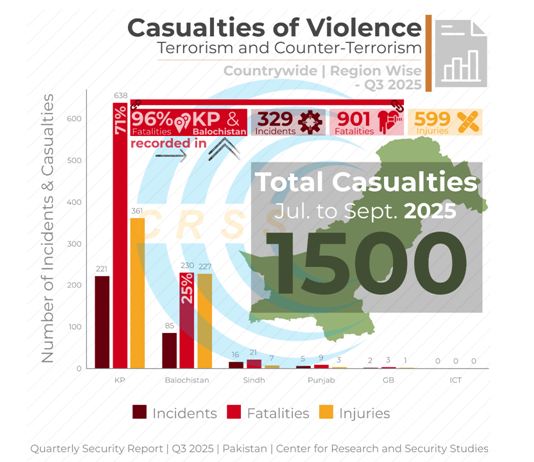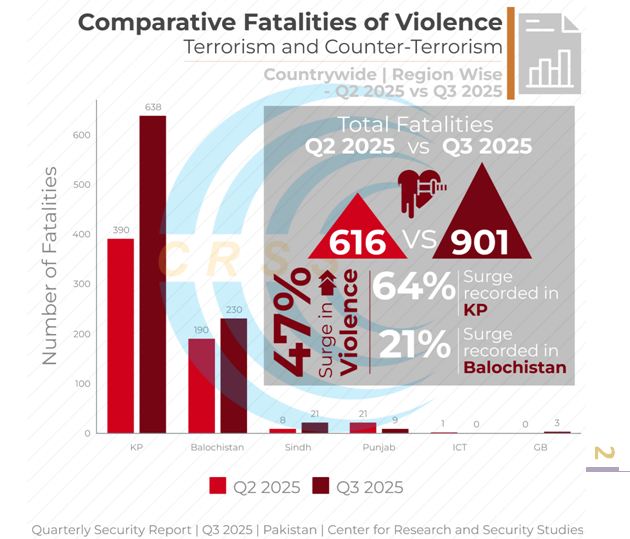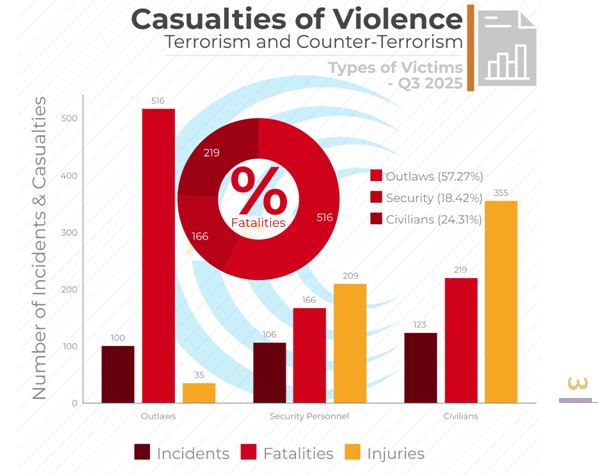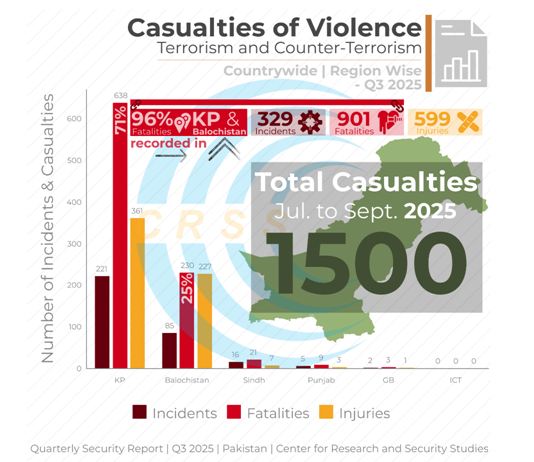ISLAMABAD, SEPT 30 /DNA/ – With at least 901 fatalities and 599 injuries – among civilians, security personnel, and outlaws -resulting from 329incidents of violence, including terror attacks and counter-terror operations, Pakistan witnessed an over46% surge in overall violencein its security landscape for the third quarter of 2025, according to the Center for Research and Security Studies (CRSS).
In just three quarters, 2025 has proven nearly as deadly as all of 2024, with 2414 fatalities recorded compared to the entire tally of 2024 (2546), which, with an entire quarter still remaining, indicates that i) 2025 is on course to surpass last year’s toll, and ii) intensification of militant violence and the expanded scale of counter-terrorism operations. If the current trend continues, 2025 could mark one of the deadliest years in a decade.
A year-on-year comparison reinforces this shift. Between January and September 2024 (Q1-Q3), Pakistan recorded 1,527 fatalities. The toll of 2414 fatalities for the same period in 2025marks a 58% rise in violence. However, the source of fatalities has shifted; in 2024, security operations caused 505 deaths (33% of the total), while terror attacks claimed 1022. In 2025, security operations accounted for 1265 deaths – over half of the total fatalities.This shift underscores how the state’s response has intensified, with security forces inflicting heavier losses on militants.

Accounting for over 96% of the country’s violence in this quarter, Khyber Pakhtunkhwa (KP) and Balochistan stood out as the most volatile provinces. KP was the worst-hit region, suffering nearly 71% (638) of the total violence-linked fatalities, and over 67% (221) of the incidents of violence, followed by Balochistan,with over 25% fatalities (230) and incidents (85). The number of fatalities, injuries, and incidents recorded in all other regions remained relatively low.
Compared to Q2, 2025, the total fatalities jumped from 616 to 901 in the period under review, a metric behind the reported over 46% rise in violence, where the most significant increase was recorded in KP and Balochistan, with 64% (from 390 to 638 fatalities) and 21% (from 190 to 230) surge, respectively. Sindh also recorded anupsurge in fatalities by 162%, though the number of fatalities was low; from 8 in Q2 to 21 in Q3, 2025.
It is worth noting that in the last quarter, CRSS had reported around 32% and 40% less violence recorded in Khyber Pakhtunkhwa (KP) and Balochistan provinces, respectively, compared to Q1.

Analysis of the security landscape in Q3, 2025 by the victims of violence reveals some interesting security trends; with both alarming and encouraging insights.
The total number of outlaws’ fatalities recorded (516) were still more than the fatalities suffered by security personnel and civilians combined (385).
The outlaws accounted for the majority of fatalities recorded in this quarter i.e. 57% (516), followed by civilians with over 24% (219) fatalities, and security personnel with over 18% (166).
Compared to Q2, 2025, these figures mark almost 55% more losses among outlaws (516 vs 333), over 43% among civilians (219 vs 153), and nearly 28% among security personnel (166 vs 130).
The outlaws may have suffered the majority of fatalities recorded in this quarter; however, the civilians were the most targeted group compared to security officials and outlaws, in terms of the number of attacks and injuries suffered, i.e. almost 123 terror attacks, compared to security officials suffering around 106 and outlaws targeted in roughly 100 security operations. Moreover, they suffered 355 injuries compared to security officials suffering 209 injuries and outlaws with only 35.

Also, the outlaws suffering the least number of injuries, being involved in the least number of incidents (which in their case were security forces operations), and still accounting for the majority of fatalities compared to civilians and security officials, indicates a high degree of lethality and precision in state-led counter-terrorism operations.
Although security operations were three times fewer than terrorist attacks, they still resulted in nearly as many fatalities as those caused by militant violence against civilians and security forces.
Pakistan endured twin crises in Q3, 2025: the twin blows of terrorism and environmental disasters. Flash floods, glacier melts, and cloudbursts inundated homes, public infrastructure, and livelihoods and claimed 1,006 lives, while militant violence took another 901. Together, they reveal a grim reality: Pakistan’s human security imperiled by both nature’s fury and man-made violence.

















